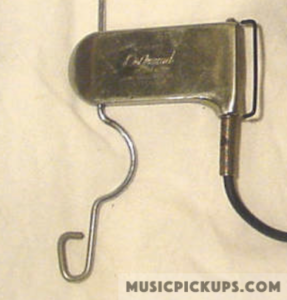This page last updated September 15, 2024.
Every DeArmond product including musical instrument pickups, effects units, amplifiers and spare parts – sold to the public through music outlets and distributors was given a specific reference number. These items are listed below, using DeArmond’s own numbering system.
The model numbers for other pickups produced for musical instrument manufacturers including D’Angelico, Eko, Epiphone, Emmons, Fender, Gretsch, Bacon Belmont, Guild, CMI (Chicago Musical Instruments), producers of Harmony, Airline, Alden, Barclay, Heathkit, Holiday, Monterey, Regal, Sears-Roebuck, Silvertone, Truetone and others), Hofner, Kustom, Levin, CF Martin, Messenger, Micro-Frets, Orpheum, Ovation, Premier, Rickenbacker and Standel (including Harptone and Koontz) are, with very few exceptions, not generally known. Where known, these numbers are included below.
DeArmond did not market any fretted Bass pickups under their own name.
The company did not disclose any technical data on their products until the release of their 1980 green catalog No, 80, which included some information on each of their then current pickups and pedals. Unfortunately the iconic models such as the Rhythm Chiefs 1000, 1100, the RHC-B and FHC-C did not appear in this catalog, as they had been discontinued by this time.
Two pickups listed below, the S-grille gold foil models 6700 and 6701, were packaged and marketed as Harmony products in Harmony catalogs, but not in DeArmond’s own catalogs or price lists.
The Model 6812, a four-scroll (moustache) pickup with a white plastic bezel, was fitted in many Harmony guitars. Another pickup listed below, the much rarer Model 6811, appears identical to the 6812 above. Rarer still, with only one example seen to date, is the Model 6813, which appears the same as the 6812. The only difference found between these pickups appears to be the method of securing the pickup itself in the bezel. See elsewhere for detailed photos. Four different heights for the bezel have been recorded so far. The base of the bezels can be either flat or with a slight convex curve on the long axis to allow for the contours of an archtop guitar body. These pickups are so named because some existing examples have one of the above numbers stamped on their underside, in addition to the company name.
Two pickups listed below, Models FP-6 and FP-12, were packaged and marketed as Fender products exclusively in the 1960s. The Model FP-6 has the edgewise volume and tone controls at the outer edges of the pickup’s chrome cover and several of these pickups, packaging and installation instructions have been seen. It has also been seen in a 1960s Fender catalog. The Model FP12 has the edgewise volume and tone controls visible through slots within the pickup’s chrome cover. Just one example of a partly-assembled FP-12 has been seen, but not in Fender’s literature to date. Both pickups have chrome covers with the Fender transitional logo embossed and individual adjustable pole-pieces.
Some re-sellers who produced their own catalogs used their own numbers when marketing DeArmond pickups. For example, Kay’s 1963 catalog shows twelve DeArmond products, including the Model 1000, which is shown there as item No. 47385F2650. Also, DeArmond’s Model 60 (without a serial number on the front face) and Model 60A (with a serial number on the front face) Tremolo units were marketed by Carvin as Model 601 (and subsequently copied by others) , which has subsquently led to some confusion.
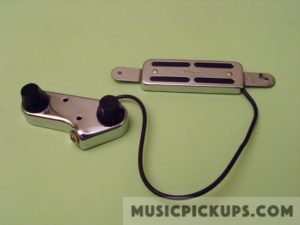
Model 40 Attachable pickup, chrome-finished with no visible pole-pieces and four black-filled slots, for flat-top roundhole guitar. This is a basic bar magnet pickup, similar to the plain ‘Hershey Bar’ type, positioned within the soundhole and is screwfixed to the front face of the guitar through two tabs (Ouch!). The pickup’s top cover is rivet-fixed through the bar magnet to the pickup’s steel baseplate. A separate V & T (Volume & Tone) open-backed controls box, hardwired to the pickup head, is screwfixed directly into the guitar’s top (Ouch again!), terminating in a mini-jack socket. The example shown above has two black, cylindrical, tapered knobs and mini-pots with 1/8″ Dia. split chamfered shaft. The shape of the separate V & T controls box shown changed over the years.
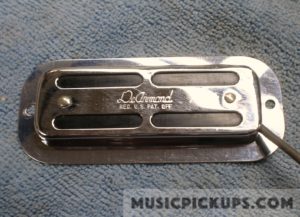


Model 41 Attachable chrome pickup with no visible pole-pieces and four black-filled slots, for archtop or flat-top guitar. This is a basic bar magnet pickup, similar to the plain ‘Hershey Bar’ type. It has an integral chrome bezel and is screwfixed to the front face of the guitar. This bezel is designed to follow the contour of the archtop body, or sit flat (see photo No. 3 of 3 above). A separate V & T (Volume & Tone) controls box, hardwired to the pickup head, is screwfixed directly into the guitar’s top, terminating in a mini-jack socket.
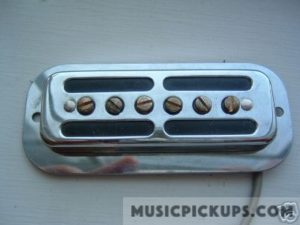
Model 55 Attachable chrome pickup with four black-filled slots and six individually adjustable pole-pieces, for archtop guitar with separate controls box, both screwfixed directly into the guitar’s top. The fixing arrangement is as for Model 41 above. A separate V & T (Volume & Tone) controls box, hardwired to the pickup head, is screwfixed directly into the guitar’s top, terminating in a mini-jack socket.
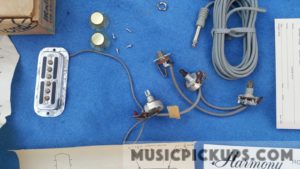
Model 55-FB-12 Set of two Model 55 pickups with wiring harness including three pots (Volume, Tone and Blender controls – no switch) and output jack socket. The pots were designed to be flush-mounted into the guitar’s top, with all wiring concealed.
Model 55-FB-7 Model 55 pickup with wiring harness including separate V & T controls and output jack socket, as manufactured. The V & T controls were designed to be flush-mounted into the guitar’s top, with all wiring concealed.
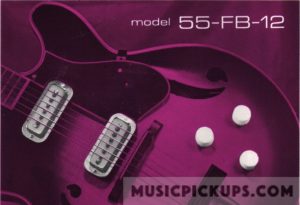
The pickup as shown above – chrome bezel, six adjustable pole-pieces, two rivets holding bezel to coil housing, white top area, installed in a Harmony guitar – did not go into production in that format. The illustration above is from DeArmond’s 1965 catalog.
Model 55-FB-7 Model 55 pickup with wiring harness including separate V & T controls and output jack socket, as manufactured. The V & T controls were designed to be flush-mounted into the guitar’s top, with all wiring concealed.
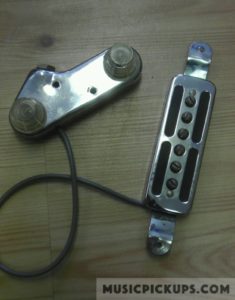
Model 56 Attachable chrome pickup with four black-filled slots and individual pole-pieces, for flat-top roundhole guitar with separate V & T controls box, both screwfixed directly into the guitar’s top, terminating in a mini-jack socket
.
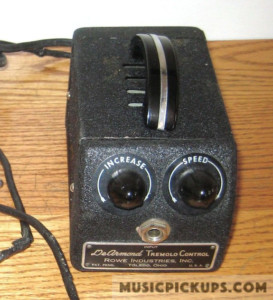
Model 60 Tremolo pedal, without serial number (120 Volts electrical supply required). This example has the same knobs as shown in Rowe Industries’ July, 1941 Leaflet. The brown, domed, ribbed knobs were shown on the earliest versions only and did not appear on any other product. Although no serial number is shown on this, the first version, several examples seen have the number printed on the internal frame.
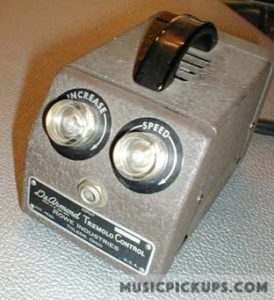
Model 60A Tremolo pedal, with serial number (120 Volts electrical supply required)
One Model 60A was used by Les Paul for several years. The two photos below show a transformer fitted by Les to the back of the unit, to enable him to switch quickly between high impedance and low impedance inputs:
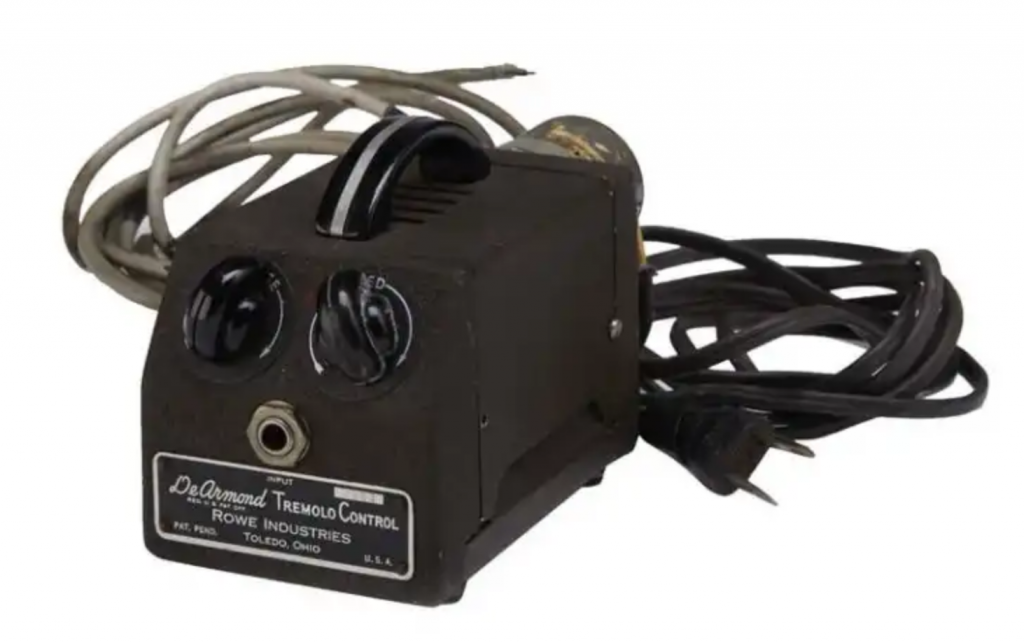
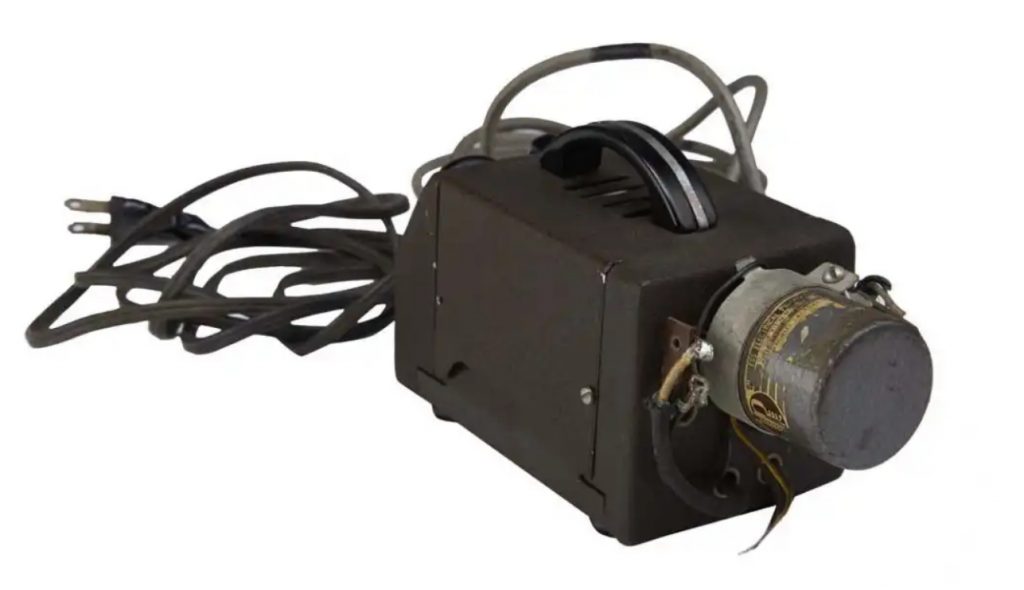
Two images above courtesy of liveauctioneers.com and Guernsey’s, New York (B0600).
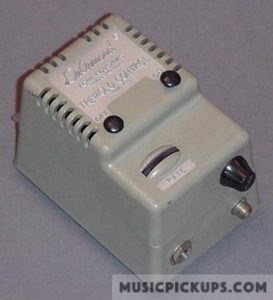
Model 60B Tremolo pedal (120 Volts electrical supply required)
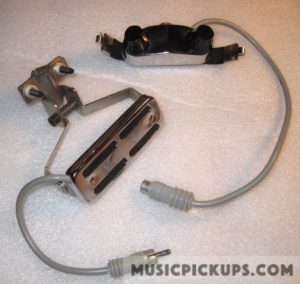
Model 76 Attachable chrome pickup for banjo, with separate V & T controls box secured with elastic straps to the edge of the banjo. This pickup’s coil housing is very similar to the Model 40 above, but without the embosssed ‘DeArmond’ name.
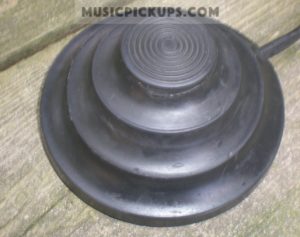
Model 100 TFS-100, Tremolo foot switch, incorporating an 8-foot connecting cable with a standard jack-plug. One of these was supplied with every tremolo-equipped amp produced by DeArmond, including those sold by CF Martin. For more information, see ‘DeArmond Tube Amps’.
Model 100 TFS-100R, Tremolo foot switch as above, but with miniature phono plug.

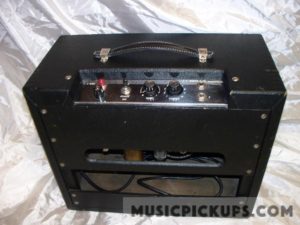
Model 110 CF Martin vacuum tube amp (as DeArmond R5 amp)

Model 110T CF Martin vacuum tube amp (as DeArmond R5T amp)
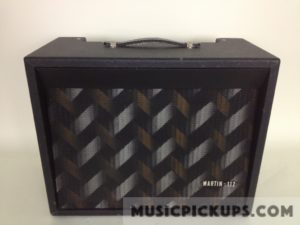
Model 112 CF Martin vacuum tube amp (as DeArmond R15 amp)
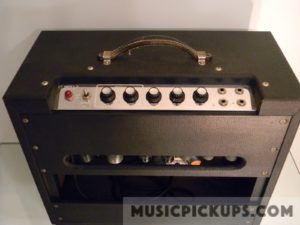
Model 112T CF Martin vacuum tube amp (as DeArmond R15T amp)
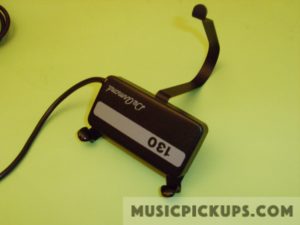
Model 130 Attachable black single-coil pickup for roundhole flat-top guitar. This pickup has the same shape and appearance as the DeArmond attachable humbuckers nos. 230, 240 and 240 which are all humbuckers.
Model 200 – There is no such DeArmond pickup. DeArmond produced the model 2000 pickup as used by Gretsch (who named it the Dynasonic Fidela-Tone), Guild, Hofner, Levin, Premier and many others. The earliest instance seen to date of the Model 2000 being incorrectly referred to as a 200 is in a July/December 1999 copy of Guild Gallery magazine, which was most likely produced when under Fender’s control (thanks to Gary of https://www.gad.net/Blog/ for this info).
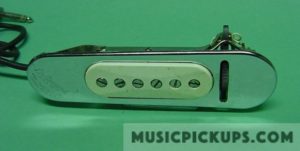
Model 210 Attachable chrome pickup with adjustable pole-pieces and recessed edgewise volume controller for roundhole flat-top guitar. One example of this pickup has been seen with a self-adhesive plastic woodgrain finish.
Model 210-C as model 210 but with side-mounting jack and quick-disconnect cable
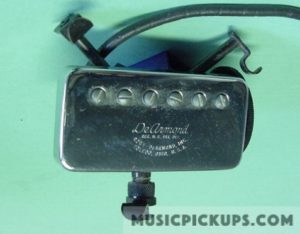
Model 220 Attachable chrome humbucker, 1st version, with integral volume controller, for roundhole flat-top guitar. The two fixing arms on the pole-pieces side are spring-loaded and the third arm has a collet which is tightened manually to set the pickup in position. This pickup is one of six attachable DeArmond pickups for roundhole guitars demonstrated by me in a Youtube video
This was Rowe DeArmond’s first humbucker and at 2.92″ x 1.517″ (74.18 x 37.54 mm.) has different dimensions than other humbuckers. The company’s subsequent humbuckers – Models 2200, 2300 and 2400 – were all slightly narrower and longer, at 2.756″ x 1.549″ (70.00 x 39.28mm.) It should be remembered that this pickup was produced at a time when ‘standard dimensions’ for these items did not exist.
Model 220-C as model 220 above but with side-mounting jack and quick-disconnect cable.
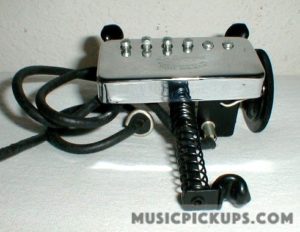
Model 220 Attachable chrome humbucker, 2nd version, with integral volume controller, for roundhole flat-top guitar. Available in chrome or gold finish. The two fixing arms on the pole-pieces side are as before, but the collet was replaced by a spring-loaded arm which makes installation and removal easier. This pickup is one of six attachable DeArmond pickups for roundhole guitars demonstrated in a Youtube video
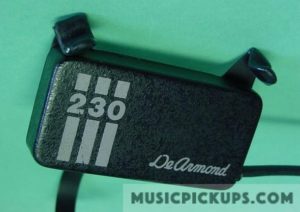
Model 230 Attachable black humbucker, roundhole flat-top guitar. This pickup is one of six attachable DeArmond pickups for roundhole guitars demonstrated in a Youtube video
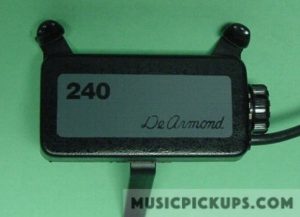
Model 240 Attachable black humbucker with integral volume controller, roundhole flat-top guitar. This pickup is one of six attachable DeArmond pickups for roundhole guitars demonstrated in a Youtube video
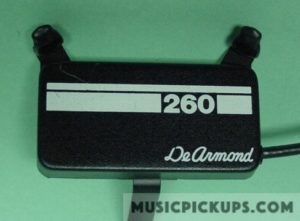
Model 260 Attachable black humbucker, roundhole flat-top guitar. In addition to the normal humbucking coils configuration, this pickup incorporates an internal Piezo pickup. This unique pickup was designed by Ken Zuercher, who worked in DeArmond Inc. as a Design Engineer from 1978 to 1983. Ken currently manufactures tube amps in Toledo, Ohio, as www.redguitaramps.com. This pickup is one of six attachable DeArmond pickups for roundhole guitars currently demonstrated in a Youtube video
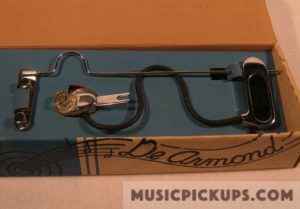
Model 400 Attachable chrome pickup with black insert for archtop tenor guitar with separate V control box and clamp; with black plastic infill; yellowed acrylic conical ribbed knob; asymmetrical pot box; 1/8″ dia. pot shaft; flush pot box lid.
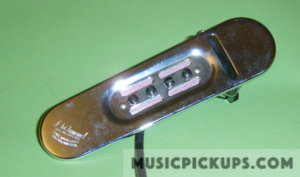
Model 450 Attachable chrome pickup with adjustable pole-pieces, for flat-top, roundhole tenor guitar with edgewise volume control,
Model 450-C as model 450 above but with side-mounting jack and quick-disconnect cable
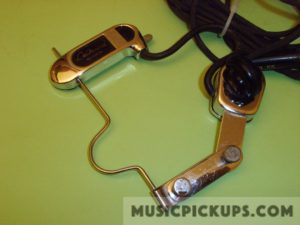
Model 500 Attachable pickup for archtop mandolin, 1st version, chrome, with a bar across the black plastic infill. Black chickenhead knob; symmetrical pot box; 1/4″ dia. pot shaft; overlapping pot box lid. The separate pot box and clamp are quite similar to those used with the FH/FHC pickups.
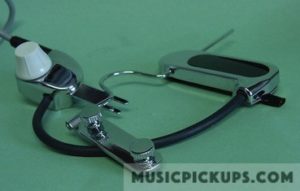
Model 500 Attachable pickup for archtop mandolin, 2nd version, chrome, with unbroken plastic infill. white conical ribbed knob; asymmetrical pot box; 1/8″ dia. pot shaft; flush pot box lid. Otherwise as 1st Version above.
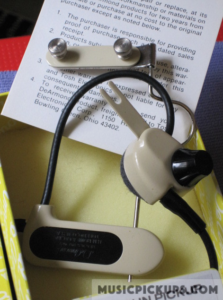
Model 500 Attachable pickup for archtop mandolin, finished in white, otherwise as 2nd Version above.
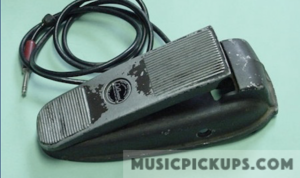
Model 600 Volume control pedal. This pedal, DeArmond’s earliest foot-operated volume controller, has the pattern of the ribbing molded into the treadle, whereas later treadles have ribbed rubber strips fixed to the treadle with adhesive.
Model 601 There is no such DeArmond pedal. DeArmond’s Model 60 pedal has been incorrectly referred to as ‘Model 601’ in some guitar magazines.
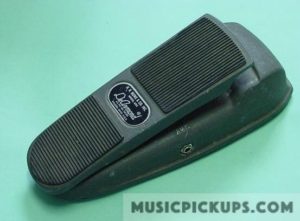
Model 602 Volume control pedal
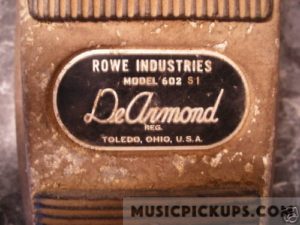
Model 602 S-1 Expression pedal, based on Model 602, with one standard jack socket
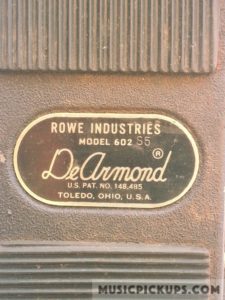
Model 602 S-5 pedal, based on Model 602, with two muticore hardwired cables
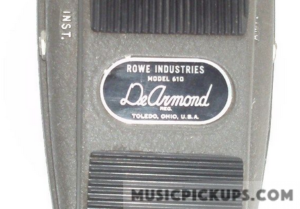
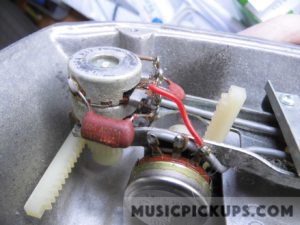
Model 610 Combination volume & tone control pedal. Volume is controlled by up/down movement of the treadle as with other volume controllers (see the lower pot in the above photo). Tone is controlled by sideways movement of the treadle (see the upper twin-gang pot with two capacitors in the above photo). This twin-gang tone control is the same arrangement as in all of CF Martin’s electric archtop guitars fitted with DeArmond pickups).
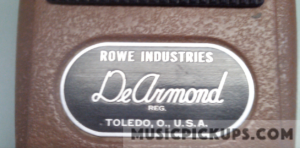
Model 610 Combination volume & tone control pedal without name, 2nd version. This pedal has ‘# 610 VolumeTone Control’ stamped on its baseplate.
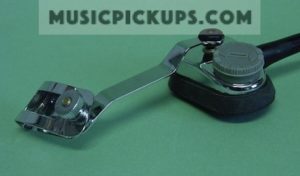
Model 700 Attachable Transducer with integral volume controller for violin, in original chrome finish.
NOTE: The transducer shown above is common to other DeArmond pickups including Models 750 (ukulele) and 800 (Round-hole, flat-top Spanish guitar).
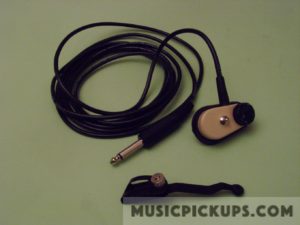
Model 700 Attachable Transducer for violin in later white finish with integral black Centronics volume controller and black clamp for violin
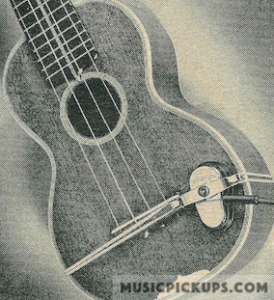
Model 750 Attachable Transducer for ukulele in chrome, secured to the instrument by means of clamp and long rubber bands.
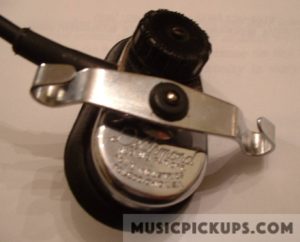
Model 750-C Attachable Transducer for ukulele in chrome as above, but with integral CRL (Central Radio Laboratories) black volume controller and clamp.
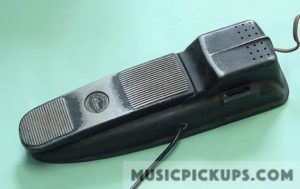
Model 800 Trem-Trol tremolo pedal (120 Volts electrical supply required)
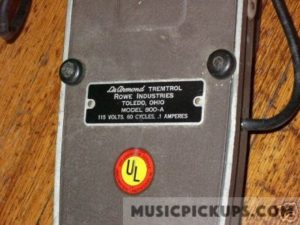
Model 800-A Trem-trol tremolo pedal, updated (120 Volts electrical supply required)
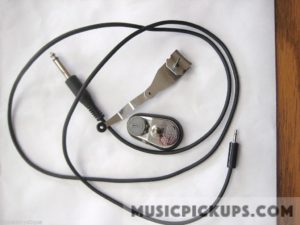
Model 800 Attachable transducer pickup for roundhole flat-top Spanish guitar
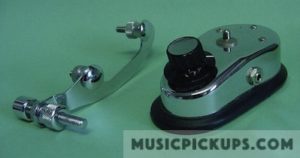
Model 900 Attachable transducer pickup for Bass Viol
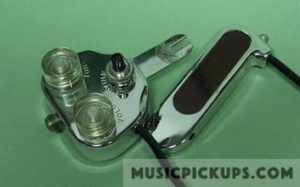
Model 1000 Rhythm Chief, attachable pickup for archtop guitar, without adjustable pole-pieces, with separate V & T controls box, in chrome or gold. Early version shown in chrome with overlapping lid on controls box; transparent cylindrical knobs: screw-in cable connector; black or maroon infill on pickup head; long pressure rod and clamp. Short support rod option available later. Controls, as described in their 1954 catalog, include a “Volume , Rhythm Switch and Tone Compensator’.

Detail of rod and bracket assembly for pickup Model 1000, Part No. ML-49.

Model 1000 Rhythm Chief attachable pickup. This version shown was produced for Guild, for their Artist Award guitars but not sold as such to the general public. Volume controller in asymmetrical box with screwed connection; short support arm woodscrew-fixed to neck; white infill on pickup head, engraved ‘Guild Artist Award by DeArmond’; black infill version engraved in white was also produced.
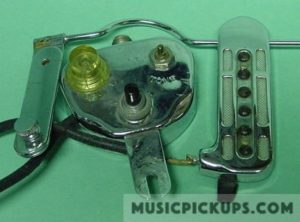
Model 1100 Rhythm Chief Attachable adjustable pickup with individually adjustable poles, for archtop guitar, with separate V & T controls box as Model 1000, in chrome; long pressure rod and clamp. Short support rod option available later.
Model 1100-G Exactly as Model 1100 Rhythm Chief Attachable adjustable pickup above, but with metalwork finished in gold.
.
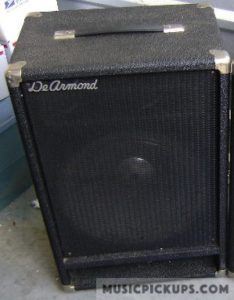
Model 1122P PA speaker enclosure
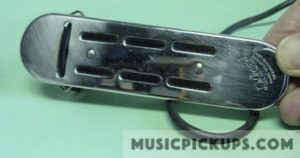
Model 1200 Attachable pickup for 12-string roundhole flat-top guitar and recessed edgewise volume controller. One example of this pickup has been seen with an adhesive plastic woodgrain finish.
Model 1200-C As Model 1200, but with quick-disconnect cable
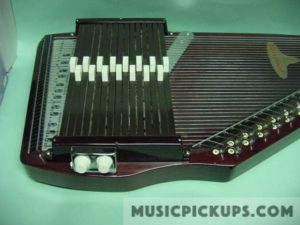
Model 1300 Attachable pickup for autoharp, 1st version
Model 1300-B Attachable pickup for autoharp, 2nd version
Model 1300-ESK Electric string kit for pickups models 1300 and 1300B
The Model 1300 was included in DeArmond catalogues from 1967 to 1983.
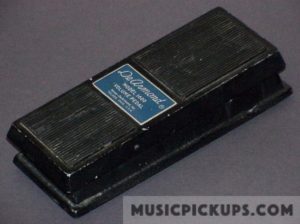
Model 1600 Volume pedal
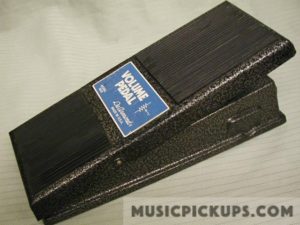
Model 1602 Volume pedal
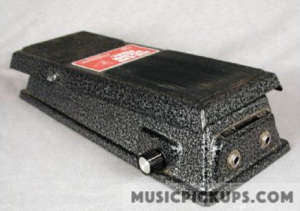
Model 1604 Pre-amp volume pedal (requires internal 9 Volt battery).
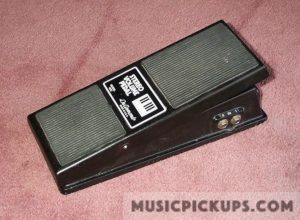
Model 1622 Stereo volume pedal
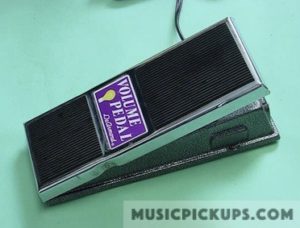
Model 1630 Opto-volume pedal (120 Volt electrical supply required)
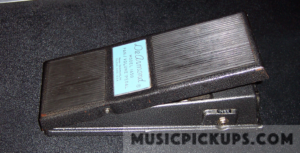
Model 1650 Pan volume stereo pedal
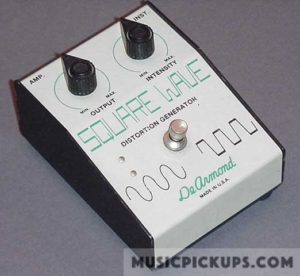
Model 1700 Square Wave pedal (requires internal 9 Volt battery)
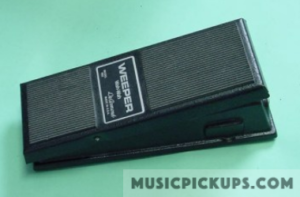
Model 1800 Wa-Wa combination volume pedal (requires internal 9 Volt battery)

Model 1802 Weeper pedal (requires internal 9 Volt battery)
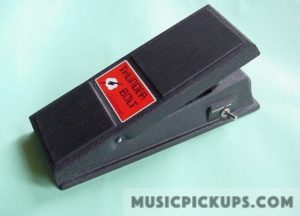
Model 1850 Thunderbolt pedal (requires internal 9 Volt battery)

Model 1900 Phaser pedal (requires internal 9 Volt battery)
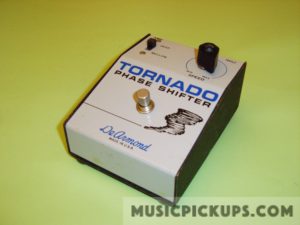
Model 1920 Tornado phase shifter pedal (requires internal 9 Volt battery)
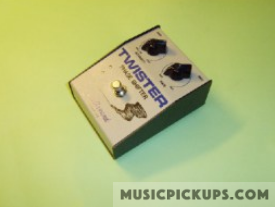
Model 1930 Twister phase shifter pedal (requires internal 9 Volt battery)
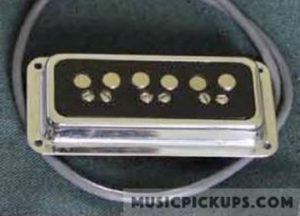
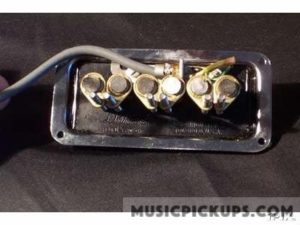 Model 2000 B Guitar pickup, original version, referred to as ‘Dynasonic’ & ‘Fidelatone’ by Gretsch, neck position, in chrome with black insert or gold with white insert
Model 2000 B Guitar pickup, original version, referred to as ‘Dynasonic’ & ‘Fidelatone’ by Gretsch, neck position, in chrome with black insert or gold with white insert
Model 2000 T Guitar pickup, original version, bridge position in chrome with black insert or gold with white insert.
The only difference between the B and T versions is the height of the bezels.
Model 2000-1 One Model 2000 pickup (B version) in chrome with black inserts with volume and tone controls
Model 2000-4 Set of two Model 2000 pickups (B and T versions) in chrome with black inserts with two volume controls, two tone controls, switch and socket.
NOTE: When the Model 2000 was first introduced by Gretsch in their 1949 catalog, it was referred to as a ‘built-in Gretsch mike’. It was referred to in Gretsch’s 1951 catalog as the Gretsch-DeArmond Fidela-Tone’ and a few years later again as the Dynasonic, but never as such by DeArmond.

Model 2200-B chrome humbucker with black bezel, for guitar, neck position
Model 2200-T chrome humbucker with black bezel, no controls, for guitar, bridge position
Model 2200-1 One Model 2200 pickup in chrome with black bezel, volume control and tone controls
Model 2200-2 Set of two Model 2200 pickups in chrome with black bezels, two volume controls, two tone controls, switch and socket
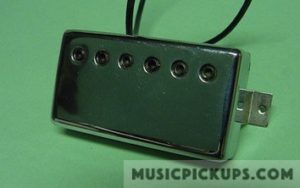
Model 2300 chrome humbucker, no bezel, with slotted pole-piece screws, for guitar, for neck or bridge position
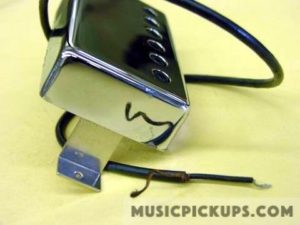
Model 2400 ‘Superbucker’, chrome humbucker, no bezel,with hex-head pole-piece screws, for guitar, for neck or bridge position

Model 2400-SC ‘Superbucker’, chrome humbucker, no bezel,with hex-head pole-piece screws, for guitar, for neck or bridge position. This version has three conductor wiring fitted, to enable individual coils to be connected. The Holland Road address dates this box as 1983.
Model 2400-G, exactly as Model 2400 ‘Superbucker’ above, but with metalwork finished in gold.
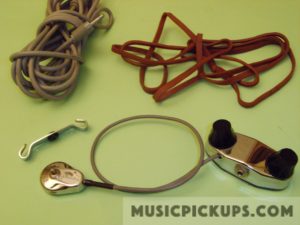
Model 3000 Piezoelectric transducer, chrome, with separate V & T controls box, for guitar
NOTE: The Piezo pickup head shown above is common to other DeArmond pickups including Models 3010 (transducer for ‘any treble clef stringed instrument’) and 3200 (twin-head transducer and pre-amp for piano & harp).
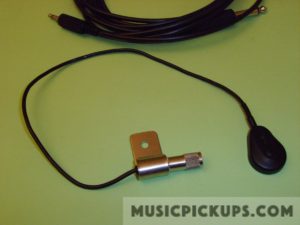
Model 3010 Piezoelectric transducer, black, for ‘any treble clef stringed instrument’
Model 3010-IMK Transducer inside mounting kit, for model 3010 above
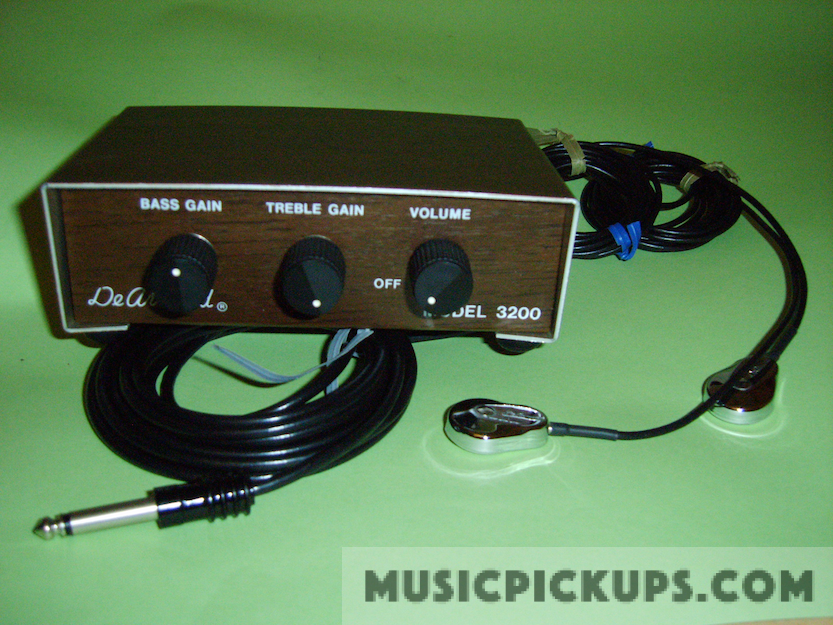
Model 3200 Piezoelectric twin-head transducer and pre-amp for piano & harp (requires internal 9 Volt battery)
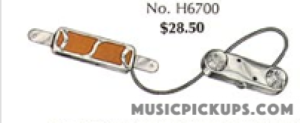
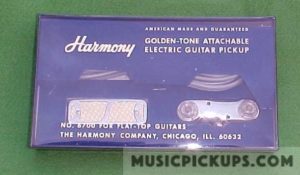
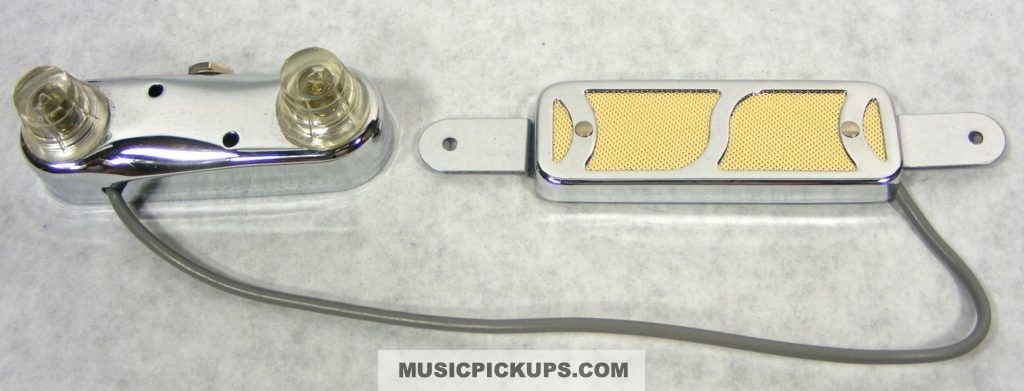
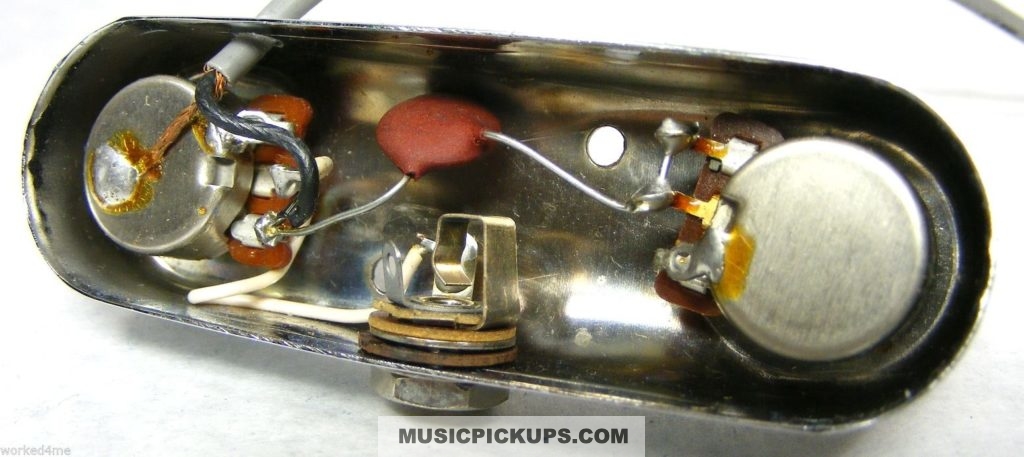
Model 6700 Attachable chrome S-grille soapbar with gold insert, for flat-top guitar, with separate V & T controls box. The difference between this pickup and Model 6701 is that the fixing bracket is offset as with the Model 40, for fixing in the roundhole of a flat-top guitar, whereas the bracket is flat in the 6701 for fitting onto an archtop body. The lower third photo above shows the pickup with its two fixing arms, offset to enable the pickup to recess into the soundhole. The fourth photo shows the interior of the controls box (B0464 – both photos copyright Works4me).
Model 6701 Attachable chrome S-grille soapbar with gold insert, for archtop guitar, with separate V & T controls box. This pickup differs from the Model 6700 above, only in having no semi-recessing offsets in the long fixing bracket. It was designed to be screwed to the top of the guitar body.
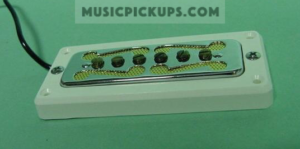
Models 6811 and 6812 pickups
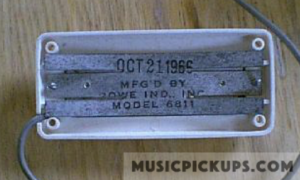
Models 6811 pickup underside
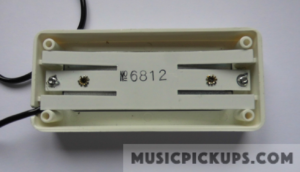
Models 6812 pickup underside
Models 6811, 6812 and 6813 Four-scroll chrome guitar pickup with white bezel, supplied only to CMI (Chicago Musical Instruments), for their range of Harmony guitars. These three versions of the same pickup do not appear in any DeArmond literature. The only difference between the quite rare 6811 and the more common 6812 may be a difference in the two fixing screws holding the pickup in the bezel. Four different heights for the bezel have been recorded so far. These pickups are so named because most existing examples – a four-scroll (moustache) pickup with a white plastic bezel – have this number stamped on their underside. The 6813 version, which is the rarest seen to date, has the same plate fixing arrangement as the 6812 version. Clicking on the underlined links will provide more information.

390-00070-90/390-00071-90 There is also an optional short offset rod used to fit the Model 1000 Rhythm Chief and model 1100 directly to the guitar’s neck. This rod can also be used to attach the FH series to the neck. Although this item was first produced in the 1950s, the first time it appeared as a separate item in DeArmond’s sales literature was in about 1975, in their orange catalog. The item numbers given are 390-00070-90 for chrome and 390-00071-90 for gold.
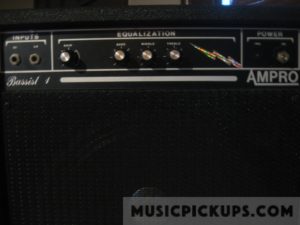
Bassist 1, Amplifier, solid state
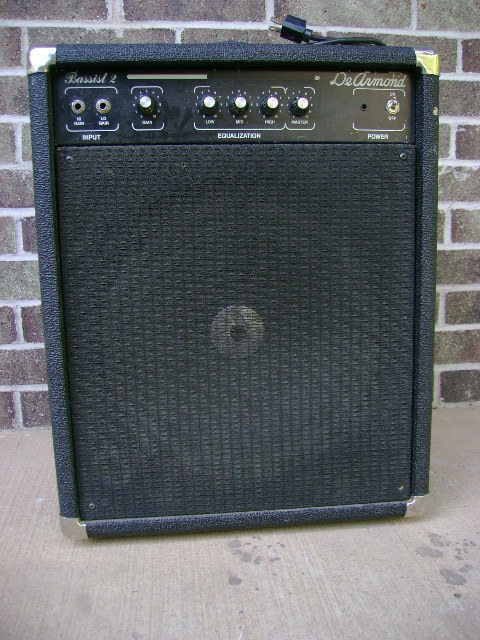
Bassist 2 Amplifier, solid state (B0149, photo copyright Suzanne).

Bassist 20, Amplifier, solid state
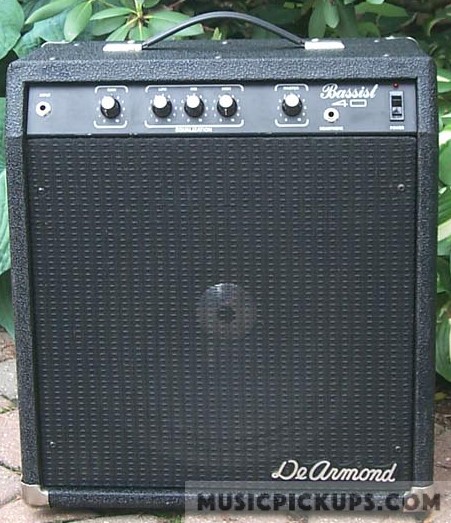
Bassist 40, Amplifier, solid state
Dynasonic, name given to Model 2000 pickup (see above) by Gretsch
Golden Tone the name given by Harmony to some of the DeArmond pickups fitted in their guitars
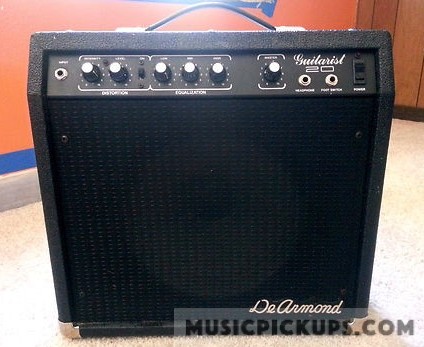
Guitarist 20, Amplifier, solid state
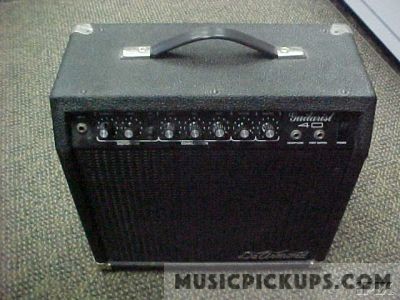 Guitarist 40, Amplifier, solid state
Guitarist 40, Amplifier, solid state
FH ‘Guitar Mike’ pickup, 1941 – front.
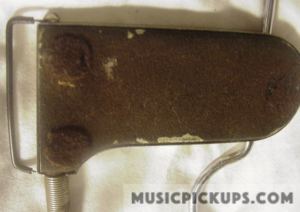
FH ‘Guitar Mike’ pickup, 1941 – back.

FH ‘Guitar Mike’ pickup, 1941 – screw fixing detail.
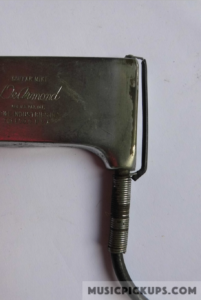 FH ‘guitar mike’ pickup, from 1941 catalog.
FH ‘guitar mike’ pickup, from 1941 catalog.
Model FH Attachable chrome ‘Guitar Mike’ for archtop, firstly with no slots, later with one slot infilled in black. At least six versions of this pickup were produced. Note the ‘hook’ arrangement which attached to the 6th string behind the bridge. This arrangement pre-dated the ‘master clamp’ attached behind the bridge. The wire on the 1st string side of the pickup pre-dates the metal tab seen on all later models. The wire itself is an extension of the chrome ‘spring-like’ cable protector seen on all early FH and FHC pickups.

Early FH ‘Guitar Mike’ pickup pressure rod and clamp detail.
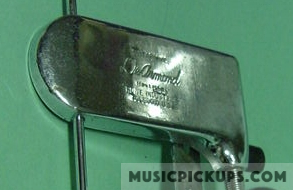
FH ‘Guitar Mike’ pickup no slots, with chrome cable protector and side tab.
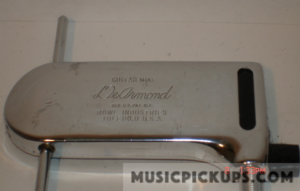
FH ‘guitar mike’ pickup with one slot filled in black, chrome cable protector and metal tab
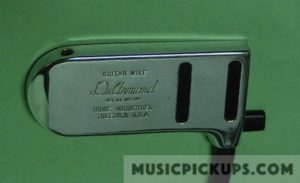
FH ‘guitar mike’ pickup with two slots, black rubber cable protector and metal tab.
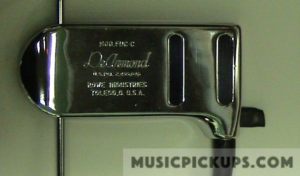
Model FHC-C Attachable chrome pickup for archtop, ‘improved’, with two slots filled black, and separate volume controller
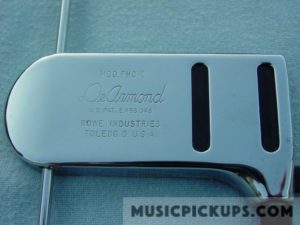
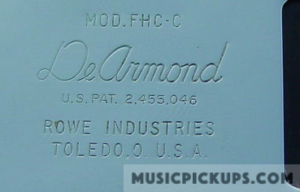
Model FHC-C Attachable chrome pickup for archtop, as above but with full Patent No. 2,455,046 shown. This Patent was granted on November 30, 1948.

FH ‘Guitar Mike’ pickup pressure rod and clamp detail, with two milled edge ‘waisted’ screws.
Model FHC-CLH, Left-handed version of Model FHC-C
Model Fidela-Tone, name given to Model 2000 pickup by Gretsch ( see Model 2000 above)
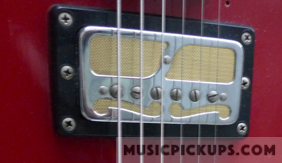
Maximum Pickup the name given by Harmony to the humbucker-sized single-coil ‘two-scroll’ pickups factory-fitted by CMI/Harmony in their guitar models H60, H60LH, H64, H72 and H72V (copyright Southside Guitars, Brooklyn)
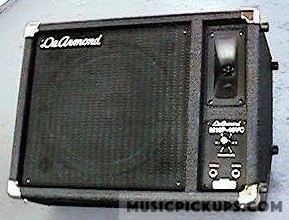
M10P-40VC, stage monitor speaker enclosure
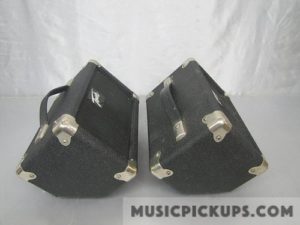
M25, PA speaker enclosure
MA-5, CF Martin’s in-house name for the pickup range manufactured for CF Martin (ref. ‘The Electric Guitar’ by Donald Brosnac.)
ML-49 (spare part) Rod and bracket assembly including clamp and screws, for pickups models 1000 Rhythm Chief and 1100 adjustable Rhythm Chief pickups described above * see Note 1 below
ML-51 (spare part) Rod and bracket assembly including clamp and screws, for pickup models 400 & 500 described above * see Note 1 below
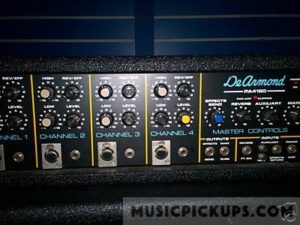
PA 4160, PA amp, solid state
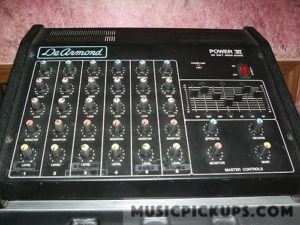
Power VI Mixer Amp, solid state
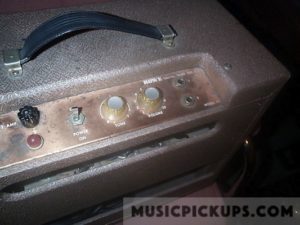
Model R5 Amplifier, vacuum tube
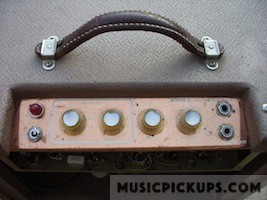
Model R5T Amplifier, vacuum tube
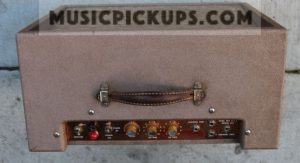
Model R15 Amplifier, vacuum tube (B0053)
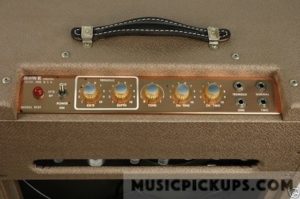
Model R15T Amplifier, vacuum tube
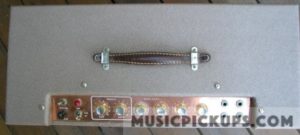
Model R25T Amplifier, vacuum tube
Model RH Attachable ‘Guitar Mike’ for flat-top roundhole guitar, firstly with no slots, as Model RHC below
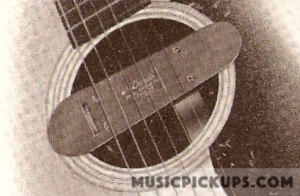
Model RHC Attachable ‘Guitar Mike’ for flat-top roundhole guitar, firstly with no slots, later with two slots, later again with three slots and lastly with four slots, all filled in black

Model RH Attachable ‘Guitar Mike’ for flat-top roundhole guitar, with two slots filled in black, no volume control.
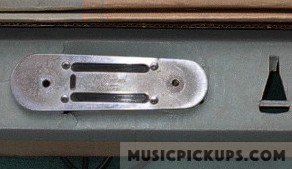
Model RH-B Attachable pickup for flat-top roundhole guitar, third version, with three slots
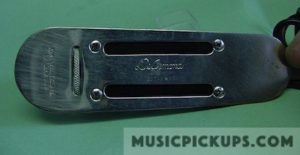
Model RHC Attachable pickup for flat-top roundhole guitar, second version, with integral volume control and two slots. Youtube video
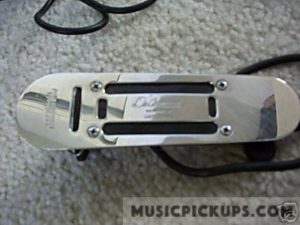
Model RHC Attachable pickup for flat-top roundhole guitar, fourth version, with integral volume control and four slots
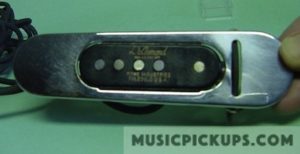
Model RHC-B Attachable pickup for flat-top roundhole guitar. According to DeArmond’s literature, the suufix ‘B’ denotes ‘improved’. This example is with integral volume control, five visible poles (and one shorter, recessed pole) and dark brown coil former. This pickup is one of six attachable DeArmond pickups for roundhole guitars demonstrated in a current Youtube video
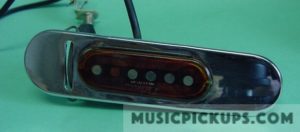
Model RHC-B Attachable pickup for flat-top roundhole guitar, ‘improved’, with integral volume control, five visible poles and translucent red coil former. This pickup is one of six attachable DeArmond pickups for roundhole guitars demonstrated in a Youtube video
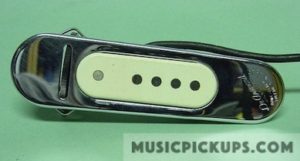
Model RHC-B Attachable pickup for flat-top roundhole guitar, ‘improved’, with integral volume control, five visible poles and white coil former
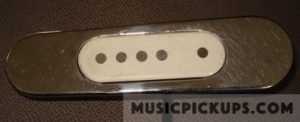
Model RH-B Attachable pickup for flat-top roundhole guitar, ‘improved’, with integral volume control, five visible poles and white coil former. As RHC-B above, but without volume controller
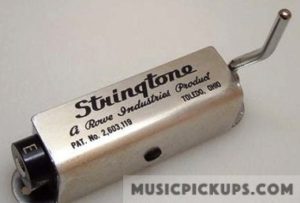
Model Stringtone bridge-mounted lever-operated tuning changer for Hawaiian guitar.
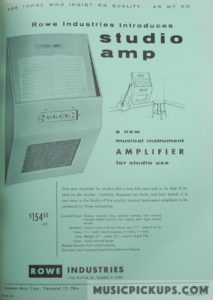
Studio Amplifier, wall-mounting version of DeArmond R5T amp, with integral sloping shelf for sheet music
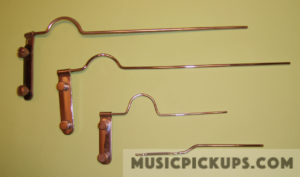
Photo 1: Three pressure rod and bracket assemblies together, for comparison.
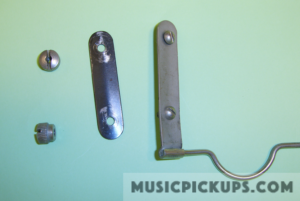
Photo 2: This bracket (at top in Photo 1 above) is an early version for FH and FHC guitar pickups. Two round-head slotted screws are screwed into threaded bracket which is secured by the two slotted nuts shown.
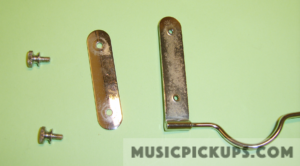
Photo 3: This bracket (middle item in Photo 1 above), Part No. ML-49, is final version of FH, FHC-B and FHC-C guitar pickups. The two milled-edge thumb screws hold the clamping strip in place.
Photo 4: This bracket (bottom item in Photo 1 above), ML-51, is for Model 500 Mandolin pickup. A second version of this bracket with a slightly longer pressure rod is used with Model 400 Tenor guitar pickup.
Notes: The rod bracket assemblies nos. ML-49 and ML-51 listed above, each comprise a rod (referred to as a ‘pressure rod’ by DeArmond), with a threaded tab attached, and a separate punched metal strip with two small thumbscrews.
The pointed end of the rod is inserted in the pickup head and the tab on the other end of the rod is clamped to the instrument’s strings behind the bridge.
The diameter of the ML-49‘s (Archtop pickups FH, FHC, FHC-B, FHC-C) rod at 1/8″ (3.175mm.) is greater than the ML-51‘s (Tenor guitar model 400 and Mandolin model 500) rod at 3/32″ (0.093mm.) so they are not interchangeable.
In DeArmond’s literature, the rod assembly is sometimes referred to as pressure rod or tension rod and master clamp. It is often referred to as a ‘Monkey on a stick’ by collectors and users, but never as such by DeArmond.

There is also an optional short offset rod used to fit the Model 1000 Rhythm Chief and model 1100 directly to the guitar’s neck. This rod can also be used to attach the FH series to the neck. Although this item was first produced in the 1950s, the first time it appeared as a separate item in DeArmond’s sales literature is in about 1975, in their orange catalog. The item numbers given to it are 390-00070-90 for chrome and 390-00071-90 for gold.

